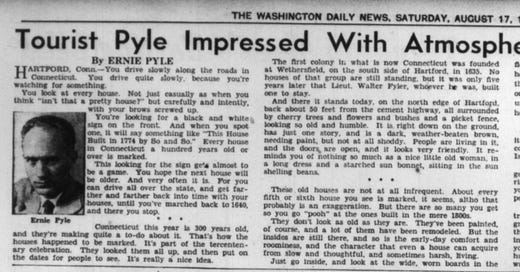AUGUST 17, 1935-Tourist Pyle Impressed With Atmosphere Of Connecticut
The Washington Daily News—Saturday—August 17,—1935
Tourist Pyle Impressed With Atmosphere Of Connecticut
By Ernie Pyle
HARTFORD, CONN.-- You drive slowly along the roads in Connecticut. You drive quite slowly, because you’re watching for something.
You look at every house. Not just casually as when you think “isn’t that a pretty house?” but carefully and intently, with your brows screwed up.
You’re looking for a black and white sign on the front. And when you spot one, it will say something like “This house Built in 1744 by So and So.” Every house in Connecticut a hundred years old or over is marked.
This looking for the sign gets almost to be a game. You hope the next house will be older. And very often it is. For you can drive all over the state, and get farther and farther back in time with your houses, until you’ve marched back to 1640, and there you stop.
● ● ●
Connecticut this year is 300 years old, and they’re making quite a to-do about it. That’s how the houses happened to be marked. It’s part of the tercentenary celebration. They looked them all up, and then put on the dates for people to see. It’s really a nice idea.
The first colony in what is now Connecticut was founded at Wethersfield, on the south side of Hartford, in 1635. No houses of that group are still standing, but it was only five years later that Lieut. Walter Fyler, whoever he was, built one to stay.
And there it stands today, on the north edge of Hartford, back about 50 feet from the cement highway, all surrounded by cherry trees and flowers and bushes and a picket fence, looking so old and humble. It is right down on the ground, has just one story, and is a dark, weather-beaten brown, needing paint, but not at all shoddy. People are living in it, and the doors are open, and it looks very friendly. It reminds you of nothing so much as a nice little old woman, in a long dress and a starched sun bonnet, sitting in the sun shelling beans.
● ● ●
These old houses are not at all infrequent. About every fifth or sixth house you see is marked, it seems. Altho that probably is an exaggeration. But there are so many you get so you go “pooh” at the ones built in the mere 1800s.
They don't look as old as they are. They’ve been painted, of course, and a lot of them have been remodeled. But the slides are still there, and so is the early-day comfort and roominess, and the character that even a house can acquire from slow and thoughtful, and sometimes harsh, living,
Just go inside, and look at the wide, worn boards in the floor, or the queer low doors, with their long hinges and heavy locks, or the deep fireplaces; or find yourself one of the secret staircases so many of them had (Indians maybe?); or go up in the attic and look at the joists and beams, so uneven and ax-marked and old. Then you won’t doubt these houses have seen things we have never known.
● ● ●
And it seems right that they should be in Connecticut, for it is certainly a state with charm. I know of no other lovelier country than that soft, sweeping woodsy land between Long Island Sound and Hartford.
It is not spectacular country. But it is a little more than gently rolling, so that you get a long view when you top a rise, and it is so green and mapled and shaded and quiet– you get a feeling that the country has character, like a person.
You can think of yourself as having sat down under a tree in Connecticut 300 years ago and still be sitting there, growing mellow with the land, and you the winner and time the loser, because time had to pass on and you’re still there in Connecticut. You couldn’t do that, of course, because you’d freeze your feet in the winter, and anyhow after a hundred years or so you’d topple over and die, but that’s the way it makes you feel, anyhow. Sort of ageless.
---
💛 **Enjoyed this post?** Your support helps us continue to transcribe and promote Ernie’s work. Please click the link below to donate.





